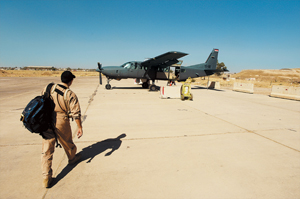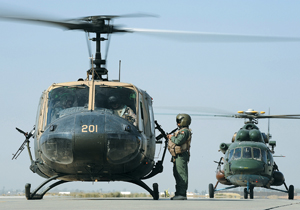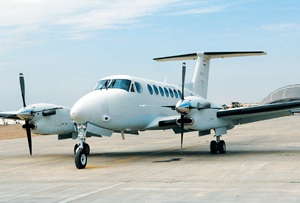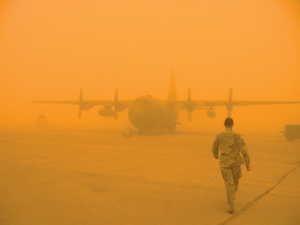As he starts up the engine of a Cessna 208B Caravan in Baghdad, Lt. Col. Nathan Brauner is at pains to inform those on board that this flight to Kirkuk, while short, should not be considered routine. He achieves his goal with a few well-chosen words: “If we go down, and if you can’t drink it or can’t shoot it, leave it behind.”
The Cessna that Brauner pilots bears the markings of the Iraqi Air Force. He is taking it north to the Kirkuk Regional Air Base. There, he advises US trainers in what is now a critical mission: the resuscitation of Iraq’s battered but still breathing airpower arm.
 |
An Iraqi pilot heads to an Iraqi Air Force Cessna Caravan he will fly on a training flight with a USAF instructor. |
The Iraqi Air Force—known as IqAF—was once the world’s sixth largest military air arm. As recently as 2006, however, it was close to nonexistent, having been all but destroyed in two deadly encounters with the US Air Force. By early 2007, IqAF was down to a scant 30 sorties a week.
The task of turning around this situation was handed to a new unit, the Coalition Air Force Transition Team (CAFTT).
Maj. Gen. Robert R. Allardice, who commanded CAFTT until early 2008, recalled what things were like when he arrived in Baghdad: IqAF had 700 troops, 28 flyable aircraft, no basic training system, no training curriculum, and no functioning air operations center.
By early 2008, change was noticeable. With the help of advisors, the Iraqis had built up to a force of some 1,350 troops and had 450 students in the basic training pipeline. Of more importance was the fact that IqAF’s optempo had risen to about 300 sorties a week.
Today, the size of IqAF has doubled again to about 2,100 airmen. The service hopes to meet an interim end strength goal of some 6,000 troops by the end of this year, on its way to a final target strength of 18,000 in 2020. Sorties are up, too.
As of Nov. 8, IqAF had 78 aircraft. This total included eight Cessna 172 and three Cessna Caravan 208B fixed wing aircraft and five Bell Jet Ranger and 10 OH-58 helicopters, all for training.
Iraqi officials have plans to build their fleet to about 174 aircraft by the end of 2010. The fleet also includes 17 Mi-17 and 16 UH-II helicopters (flown by IqAF squadrons based at Taji), one King Air LTA, and three C-130Es, all for battlefield mobility.
IqAF has moved to buttress its battlefield intelligence-surveillance-reconnaissance capability in particular. Included in the current force for that purpose are eight CH-2000, three Cessna Caravan 208B, and four King Air fixed wing aircraft for ISR missions.
The Iraqi Air Force expects to take delivery of 14 additional aircraft in early 2009, including Bell Jet Rangers, Cessna 172s, and Cessna Caravans for training. The acquisition will also include a King Air ISR platform and two armed Cessna Caravans.
Those two Caravans will give Iraq’s air force a ground attack capability for the first time since the fall of Saddam’s regime. The armed Cessnas, dubbed “Combat Caravans,” were to arrive in December with Hellfire missile kits.
Even as the coalition nations embark on a force drawdown, airmen helping to build Iraq’s air force are seeing their mission grow in importance, along with the size and capabilities of the recuperating service.
“We’re here to help build a credible and enduring air force,” said Col. Sean M. Frisbee, CAFTT chief of staff, in November in Baghdad.
Frisbee describes the CAFTT’s work as a process of “shrink and share”—as US forces draw back, teams of advisors and support personnel integrate with Iraqi units and allow them to slowly take over operations.
 |
An Iraqi UH-1H Iroquois (l) and an Iraqi Mi-17 Hip at Joint Base Balad. Both helicopter types are being used by the Iraqi Air Force for personnel movement missions. |
Building a Force
The Air Force will be a factor in Iraqi security for some time to come. Still, USAF seeks to build up its Iraqi counterpart such that it can, on its own, deter external aggression, and act as appropriate to help maintain internal security.
Today, the 350 airmen and coalition personnel of the CAFTT are working with 2,100 members of IqAF in a wide range of air efforts. They are teaming to establish a command and control network, an air operations center, and professional military education curricula, to name a few key initiatives.
They are also standing up across the country new rotary and fixed wing aircraft centers.
As the Iraqis gain more aircraft and infrastructure, they are simultaneously integrating into the force new pilots, engineers, and maintainers. Many older Iraqi pilots are expected to retire—Frisbee points out that 148 pilots in IqAF today have more than 10 years of flight experience, but by 2018, the number is expected to dip to 83.
The key to the future of the Iraqi Air Force—oft repeated by Iraqis and advisors—is a buildup of well-trained personnel.
Today, youth is in heavy demand; the average age of the Iraqi airman is 45 years. Many are about to retire and collect pensions, so most effort is directed at recruiting younger troops who will form the nucleus of the future force. Iraqi lieutenants going into pilot training today will be in leadership roles in just a few years.
“We’re helping to build the foundation for the future of this force,” Frisbee said.
Once, before the Gulf War, IqAF was a force filled with Soviet-produced fighters and bombers. Those are mostly gone. The workhorses of today’s Iraqi Air Force are far less conspicuous on the military ramp at Baghdad Airport—now known to Iraqis as New Al Muthana Air Base.
Take, for example, the King Air 350. The Iraqi Air Force possesses several of these twin-engine aircraft, three of which recently were lined up on the base runway. One had just returned from a surveillance mission along the Iranian border, flown by Iraq’s own ISR airmen.
These kinds of missions are flown all the time—routes up and down the Iranian border, collecting data and learning how to operate the equipment, said Maj. Bryan Lee, the director of operations for the 321st Air Expeditionary Advisory Squadron.
IqAF uses Baghdad as the hub for the operation of two squadrons—Squadron 87, which flies King Airs, and Squadron 23, which uses US-built C-130Es.
Lee—a B-1B pilot by background—and several other advisors and sensor operators work every day with seasoned Iraqi pilots who just a few years ago were flying MiG-23s, MiG-25s, and other Soviet bloc fighters.
 |
The King Air 350I aircraft, shown here between missions at an Iraqi base, is currently the most advanced ISR aircraft in Iraq’s fleet. |
Intelligence in High Demand
“They’re great guys, great pilots,” Lee said, noting, “Many of the guys I was trying to bomb, now I want to work with them.”
In late 2008, the Iraqi King Air crews became mission capable. Two Iraqi pilots and a sensor operator flew their first full ISR mission in early November. The sensor package aboard, including a synthetic aperture radar, infrared, and ground moving target indicator, is among the most advanced equipment in the Iraqi portfolio.
And the data gathered is in high demand at the Iraqi Ministry of Defense and Army units. Lee called the ISR aircraft remarkably similar to USAF’s RC-12 Liberty, which USAF is expecting to deploy to the theater.
“We go off and practice with the [ground station operators, and we’ll radio and say,] ‘Around that next corner is a guy with an AK-47; be careful,’ ” Lee said of the Iraqi sorties. “We’re constantly working the communications piece between here” and wherever the ground stations are deployed.
In Kirkuk, a city on the edge of Iraq’s Kurdish region, the young Iraqi Air Force is making more great strides.
Three Cessna Caravan 208Bs flying out of Kirkuk Regional Air Base, supplement IqAF’s ISR capabilities by performing daily missions in support of a wide range of Iraqi operations.
Lt. Col. Jean Havens, commander of the 521st AEAS, works with former MiG and Mirage pilots flying in Squadron 3. Squadron 3 is the unit responsible for the Iraqis’ primary ISR aircraft, the Cessna Caravan.
The first three Caravans were delivered in mid-2007. As of Nov. 1, the squadron had flown more than 1,180 sorties in the airplanes, for a total of 2,310 hours. The aircraft supports Iraqi Army forces and conducts surveillance of power lines, oil pipelines, and other infrastructure, Havens explained.
In October, Caravan ISR support was instrumental in aiding heavy Iraqi special operations raids in and around Mosul, where Iraqi forces targeted and rolled up 25 “high-value” human targets using information gathered by IqAF, according to Havens.
“The Iraqis just got those Caravans about a year ago; now they are flying 75 percent of their operational missions,” said Lt. Col. Robert Schreffler, the 521st director of operations. The Iraqis “perform very well with it.”
Operational success aside, the Iraqis and American advisors are constantly working to iron out cultural and organizational differences.
The work includes making sure ISR assets are used in an efficient manner, setting up processes properly, and pushing airmen and field commanders to make decisions without “kicking things upstairs” to senior leadership. (The Iraqi Minister of Defense can monitor King Air ISR feeds from his desk.)
Capt. Emery Breznai, director of maintenance with the 521st, said he works with older Iraqis and younger recruits on “level 1” maintenance skills such as launch, recovery, preflight checks, and other activities. A contractor provides the more involved back shop maintenance.
“We have to keep our minds in the right place,” Breznai said of the training challenges. “Let the Iraqis handle the problem as best they can.”
Maintainers—just like pilots—must go through tough English language training since much of the technical data on aircraft in the Iraqi force is not available in Arabic. Iraqi officials hope to be able in a few years to conduct basic maintenance organically, and only contract on heavy depot-level repair, Breznai added.
Aviation culture can be transmitted, but it takes time.
“Many of these guys are older, and more experienced than me, … but we were there to help transition to a ‘manual driven’ air force, and I am there to share what I know,” said Capt. Steve DeHaas, a C-130 evaluator pilot from the 61st Airlift Squadron at Little Rock AFB, Ark., and a CAFTT veteran. “You earn trust, and by the end of it, these guys are asking you questions.”
IqAF has had battlefield impact. In March, IqAF C-130s played a key role in resupplying Iraqi Army and Interior Ministry troops fighting in Basra during a pitched battle fought between Iraqi military forces and elements of Moqtada al-Sadr’s Mahdi Army. The Sadrist forces were routed.
While only three Hercules are currently in the Iraqi inventory, they are heavily tasked with resupply missions and medical evacuation flights.
Iraqi Major Gassan (some Iraqis, for reasons of security, would provide only their first names) is one of Squadron 23’s C-130 maintenance officers. He said much of the basic maintenance on the airlifters is done on the ramp or in the hangar.
If necessary, the airlifters can be sent to Jordan for programmed maintenance. Spare parts availability continues to be a problem, though, as the desert is hard on aircraft and parts wear out at a fast clip. Still, Gassan and others do their best to work around problems.
In the new Air Force, older pilots train for new missions with new tactics.
At Camp Taji, a former Republican Guard airfield north of Baghdad, US advisors work with rotary wing pilots to prepare for challenging nighttime operations. These Iraqi special operations forces use the Mi-17 Hip helicopters.
 |
A USAF maintainer moves to secure an Iraqi Air Force C-130E Hercules during a sandstorm. Iraqi officials want the IqAF to conduct all basic maintenance operations itself. |
Needed: More Supplies, Logistics
At the squadron building, Iraqi pilots and crew were gathered after dinner to discuss operations and missions. Members of the 15th Squadron went through the night assault mission certification process. While Mi-17 crews have been flying evacuation and transport missions in small numbers, advisors with CAFTT’s 721st AEAS are helping prepare them for more advanced missions such as these. Pilots and crew must fly eight sorties to be certified to use night vision goggles, said Maj. Ryan Campbell, an advisor and UH-1 pilot deployed from Andrews AFB, Md.
Near-term plans call for IqAF’s Squadron 15 to train exclusively for insertion operations with Iraqi Special Forces units, says Col. Abdel Salaam, a veteran Iraqi pilot.
Not all of the pilots are certified yet, and getting the opportunity to fly brief three-to-four-hour sorties is difficult. “More training and supplies and logistics” are the things that they could use, he said.
Maj. Scott McArtt, a T-6 instructor from Columbus AFB, Miss., and Lieutenant Jawhar, an Iraqi trainee, climb into a waiting Cessna 172, run through checklists, and take off for a training flight over Kirkuk. This is the lieutenant’s sixth flight in the 172. The training pipeline, critical to the IqAF’s future, is benefiting from major investment as new facilities, simulators, and aircraft are moved to the northern Iraq base.
“We’ve come a long way,” recalled Capt. Jamie Riddle, another training advisor from Mississippi. “I was in the initial cadre when we first started. … We had aircraft, a sawhorse, a tent, and a few computers. … Now we’re up and running.”
After initial screening, Iraqi pilots use state-of-the-art simulators to hone basic skills before moving to the flight line. Trainees first fly about 56 sorties in the 172 before progressing to the 208 Caravan. As of late 2008, the training program at Kirkuk had 39 undergrad students in a one-year curriculum, with four Iraqi instructors.
Brauner, now on his fourth deployment in the CAFTT organization, leads the 52nd Expeditionary Flight Training Squadron. He said the rapid expansion of the force means there is very little room for error. Older members of the Iraqi Air Force who received professional military education were mostly Ba’ath Party members, Brauner said. Most of them fled after the war started, he added.
Assuming no attrition, those who will be colonels in a decade or so are just coming out of flight school. The new recruits have initiative; they have drive, said Brauner. “My emphasis is putting the new blood to work.”
Colonel Kareem, head of the Iraqi training squadron at Kirkuk, is a veteran Mirage pilot from the old regime. He and his family members fled Baghdad for the north during the turmoil following the US invasion in 2003. He returned when the US and Iraq began to rebuild IqAF.
With a training curriculum in place and more facilities and infrastructure on the way, Kareem said he is eager to get fresh pilots. Things are different from what they used to be, he said. “We are looking for a new kind of pilot,” he said, noting many of the pilot candidates need to have advanced English language skills and degrees in science or engineering.
The young Iraqi pilots have an eagerness to learn. “We’ve done a lot [already], and I want to make sure that the pilots flying today have the skills to take over when I am gone,” said Kareem. “They are the new air force.”